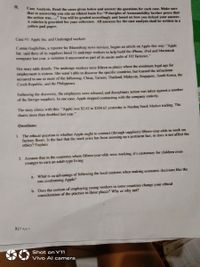
Understanding Business
12th Edition
ISBN: 9781259929434
Author: William Nickels
Publisher: McGraw-Hill Education
expand_more
expand_more
format_list_bulleted
Question

Transcribed Image Text:IL
Case Analysis. Read the cases given below. and answer the questions for each case. Make sure
that in answering you cite an ethical basis Ex: "Principles of Accountability further prove that
the action waRS...." You will be graded accordingly and based on how you defend your answer.
A rubrics is provided for your reference. All answers for the case analysis shall be written in a
yellow pad paper.
Case #1: Apple Inc. and Underaged workers
Cunnie Guglielmo, a reporter for Bloomberg news services, begins an article on Apple this way: "Apple
Inc. said three of its suppliers hired 11 underage workers to help build the iPhone, iPod and Macintosh
computer last year, a violation it uncovered as part of its onsite audit of 102 factories."
Her story adds details. The underage workers were fifteen in places where the minimum legal age for
employment is sixteen. She wasn't able to discover the specific countries, but learned the infractions
occurred in one or more of the following: China, Taiwan, Thailand, Malaysia, Singapore, South Korea, the
Czech Republic, and the Philippines.
Following the discovery, the employees were released, and disciplinary action was taken against a number
of the foreign suppliers. In one case, Apple stopped contracting wvith the company entirely.
The story closes with this: "Apple rose $2.62 to $204.62 yesterday in Nasdaq Stock Market trading. The
shares more than doubled last year.
Questions:
1. The ethical question is whether Apple ought to contract (through suppliers) fifteen-year-olds to work on
factory floors. Is the fact that the stock price has been zooming up a pertinent fact, or does it not affect the
ethics? Explain.
2. Assume that in the countries where fifteen-year-olds were working, it's customary for children even
younger to earn an adult-type living.
a. What is an advantage of following the local customs when making economic decisions like the
one confronting Apple?
b. Does the custom of employing young workers in some countries change your ethical
consideration of the practice in those places? Why or why not?
21Page
Shot on Y11
Vivo Al camera
Expert Solution
This question has been solved!
Explore an expertly crafted, step-by-step solution for a thorough understanding of key concepts.
This is a popular solution
Trending nowThis is a popular solution!
Step by stepSolved in 2 steps

Knowledge Booster
Learn more about
Need a deep-dive on the concept behind this application? Look no further. Learn more about this topic, management and related others by exploring similar questions and additional content below.Similar questions
- hi solve 1 , 2 and 3arrow_forwardFor this assignment, you are expected to demonstrate an analytical knowledge and critical understanding of different ethical perspectives, including ethical business objectives. In doing so, you are required to find and present three crucial ethical issues that have been faced by actual organizations through the years (such as equality at the workplace, racial and sexual harassment, corporate sustainability, corporate governance, corporate citizenship, environmental sustainability and/or globalization) and explain why it is essential for a management team to handle them.arrow_forwardYour friend is a human resource manager in Philadelphia. She says, “Our company’s policy isthat we won’t hire anybody with a criminal record.” Is this legal?arrow_forward
- You are going to work on a case analysis related to the issue of discrimination in employment and long-arm jurisdiction, about the case of Asahi Metal Industry, Read carefully and answer each of the following questions: As a company administrator, what type of employment discrimination, prohibited by law, should you avoid? Identify and explain at least three (3) types of discrimination. Explain and provide a brief summary of the law where the selected type of discrimination is found.arrow_forwardPart 1: What is natural justice and what are its elements? Why is naturaljustice important?Part 2: Create a fictional story where at least one of the elements of naturaljustice is missing (approximately 1500 words)arrow_forwardjob duties of a Health Commissioner are quite broad. Discuss two job duties from the job description that are extrinsic to the health department and two job duties from the job description that are intrinsic to the health department. list at least two of the job qualifications from the job description for each of the four examples that you feel your education will help prepare you for this position.arrow_forward
arrow_back_ios
arrow_forward_ios
Recommended textbooks for you
 Understanding BusinessManagementISBN:9781259929434Author:William NickelsPublisher:McGraw-Hill Education
Understanding BusinessManagementISBN:9781259929434Author:William NickelsPublisher:McGraw-Hill Education Management (14th Edition)ManagementISBN:9780134527604Author:Stephen P. Robbins, Mary A. CoulterPublisher:PEARSON
Management (14th Edition)ManagementISBN:9780134527604Author:Stephen P. Robbins, Mary A. CoulterPublisher:PEARSON Spreadsheet Modeling & Decision Analysis: A Pract...ManagementISBN:9781305947412Author:Cliff RagsdalePublisher:Cengage Learning
Spreadsheet Modeling & Decision Analysis: A Pract...ManagementISBN:9781305947412Author:Cliff RagsdalePublisher:Cengage Learning Management Information Systems: Managing The Digi...ManagementISBN:9780135191798Author:Kenneth C. Laudon, Jane P. LaudonPublisher:PEARSON
Management Information Systems: Managing The Digi...ManagementISBN:9780135191798Author:Kenneth C. Laudon, Jane P. LaudonPublisher:PEARSON Business Essentials (12th Edition) (What's New in...ManagementISBN:9780134728391Author:Ronald J. Ebert, Ricky W. GriffinPublisher:PEARSON
Business Essentials (12th Edition) (What's New in...ManagementISBN:9780134728391Author:Ronald J. Ebert, Ricky W. GriffinPublisher:PEARSON Fundamentals of Management (10th Edition)ManagementISBN:9780134237473Author:Stephen P. Robbins, Mary A. Coulter, David A. De CenzoPublisher:PEARSON
Fundamentals of Management (10th Edition)ManagementISBN:9780134237473Author:Stephen P. Robbins, Mary A. Coulter, David A. De CenzoPublisher:PEARSON

Understanding Business
Management
ISBN:9781259929434
Author:William Nickels
Publisher:McGraw-Hill Education

Management (14th Edition)
Management
ISBN:9780134527604
Author:Stephen P. Robbins, Mary A. Coulter
Publisher:PEARSON

Spreadsheet Modeling & Decision Analysis: A Pract...
Management
ISBN:9781305947412
Author:Cliff Ragsdale
Publisher:Cengage Learning

Management Information Systems: Managing The Digi...
Management
ISBN:9780135191798
Author:Kenneth C. Laudon, Jane P. Laudon
Publisher:PEARSON

Business Essentials (12th Edition) (What's New in...
Management
ISBN:9780134728391
Author:Ronald J. Ebert, Ricky W. Griffin
Publisher:PEARSON

Fundamentals of Management (10th Edition)
Management
ISBN:9780134237473
Author:Stephen P. Robbins, Mary A. Coulter, David A. De Cenzo
Publisher:PEARSON